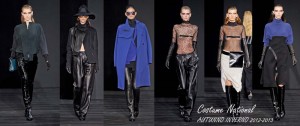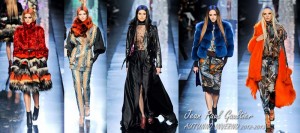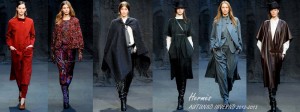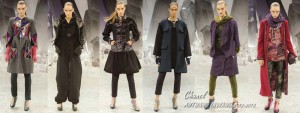Paris fashion week for Fall/Winter 2012-2013
Mysterious and dark woman’s look presented at Paris fashion week for Fall/Winter 2012-2013
Just a few weeks ago the curtains closed on the Parisian catwalks, marking the end of a rich and varied series of prêt-a-porter fashion proposals. Following on after New York, London and Milan, the renowned Paris maisons gave shape to creative and spell-binding collections dedicated to next Fall/Winter 2012-2013. Also not to be forgotten is the great contribution and the breath of freshness, innovation and extravagance provided by the new young talents who, despite the difficulties in a market ever more dominated by the classic and well-known labels and brands, strive to find their own place.
Visitors, buyers and national and international press attended this long awaited event in great numbers, and for seven days Paris – always considered the cradle of luxury and elegance – was in the spotlight. Of course the French fashion week lived up to expectations, with plenty of curiosity and news presented from March the 1st to 7th, and Italian designers being distinguished for their creativity.
Some of the most beautiful and exclusive places and venues in the city were accessible thanks to the parades, so the Paris fashion week also became an original and diverse way of discovering Paris.
But, let’s look in more detail at the many collections. This year the only rule was “not being ordinary”, with fashion houses competing to organize and present the most outstanding and dazzling show.
At Maison Martin Margiela – owned by Diesel’s founder Renzo Rosso – operators and staff members wore a white uniform as if they were in hospital, and the show took place in the magnificent palace once owned by Salomon Rothschild.
The tuxedo jackets that opened the show were faultlessly constructed with their matching pants that looked quite normal from the front until the models turned and you noticed that the hems were several inches shorter at the back.
A pair of capes also played the trompe l’oeil card with their rounded and cocoon-like shape created by sleeves stitched into pockets.
Sometimes a fashion parade becomes a real party, as happened on the Alber Elbaz catwalks, where the designer performed a song and welcomed the guests with huge cakes inside what was once a wine warehouse.
For his 10th anniversary at Lanvin, Alber Elbaz presented an incredibly rich collection: dresses with enormous ruches, evening gowns in black lace contrasting with colorful satin, big studs and jewels; the secret lay in the special combination of the various elements, sometimes bordering on dissonance, but always elegant. To exalt femininity and give emphasis to women’s curves, a great variety of body-enhancing dresses in bright and delicious shades. Golden brocade, glittering applications, beaded sheaths and exuberant prints are plentiful in such a festive collection.
 Costume National – an Italian label that is becoming more and more appreciated abroad – chooses the French stage to present its impressive collection: a lot of leather, original cuts not afraid of showing the body, for an urban and self-confident, sometimes even androgynous, woman, with references to rock music and cinema.
Costume National – an Italian label that is becoming more and more appreciated abroad – chooses the French stage to present its impressive collection: a lot of leather, original cuts not afraid of showing the body, for an urban and self-confident, sometimes even androgynous, woman, with references to rock music and cinema.
Ennio Capasa – the brand’s director –highlighted his loyalty to Made in Italy, expressing a quality that can’t be reproduced elsewhere.
In this masculine universe, the names of two woman designers come up – twin sisters Barbara and Lucia Croce who were responsible for the Vionnet collection, a French label that celebrates its 100th birthday this year, now quite entirely Italian owned. A vivid colors together with asymmetrical cuts are seen as a modern interpretation of the art deco so much appreciated by its founder. Moving away from the maison’s tradition, this year the focus was on daywear, especially pants. Trousers aren’t necessarily a part of the Madeleine Vionnet concept, but they are pretty essential to modern women’s lives, so the young duo was savvy to include them in their presentation.
 This time there were no extravagant whims and follies at Jean Paul Gaultier’s show, just high-standard products and good quality for a collection inspired by contemporary art and graffiti, with an explosion of joy and vitality that the designer feels essential: models show everything from a leather biker jacket in red with black tulle, graffiti-skirt, , the parka jacket in satin or the fox fur with colors taken from murals.
This time there were no extravagant whims and follies at Jean Paul Gaultier’s show, just high-standard products and good quality for a collection inspired by contemporary art and graffiti, with an explosion of joy and vitality that the designer feels essential: models show everything from a leather biker jacket in red with black tulle, graffiti-skirt, , the parka jacket in satin or the fox fur with colors taken from murals.
Always keeping an eye on what people really like, the new creative directors at Kenzo focus on colors and the energy that springs from designs inspired by architecture and domestic scenes: from the table cloth with bunches of grapes that turns into a print for a trench or marble tile floors for coats – double designs with zip off pieces that transform the garment into another design. The tailoring was very successful, showing up in fresh little skirt suits, of blouson jackets with full, flippy skirts, as well as in a narrow, high-waist, ankle-length skirt that was slit up the back.
Givenchy celebrated with much applause for the collection by Riccardo Tisci, which was entirely dedicated to a pushy style, very rock. Black leather is among the most used materials, presented with very strict cuts and lines and details full of energy.
 Hermes enchanted its public with a dark collection, with black leather as the main player. Far from its equestrian roots, it now embodies the apogee of modern luxury: for Hermes travel is movement, thus modernity. The collection opened with the gaucho look – knit serape, baggy leather pants tucked into boots – and closed with pieces that were printed with folkloric patterns from the Russian steppes. In between, wide trousers with flared legs or gilets made of fur. Coats are oversized but cinched at the waistline.
Hermes enchanted its public with a dark collection, with black leather as the main player. Far from its equestrian roots, it now embodies the apogee of modern luxury: for Hermes travel is movement, thus modernity. The collection opened with the gaucho look – knit serape, baggy leather pants tucked into boots – and closed with pieces that were printed with folkloric patterns from the Russian steppes. In between, wide trousers with flared legs or gilets made of fur. Coats are oversized but cinched at the waistline.
A general standing ovation welcomed Stefano Pilati’s final collection at Yves Saint Laurent: severe lines, wide shoulders, tight skirts and dresses, ankle-length trousers and metallic top reminiscent of ancient armor. Very few concessions to colors and here too a lot of leather. He was asked to restore the finances of the fashion house which was registering enormous losses, and he cleverly did it in seven years.
Despite the general economic crisis that conditioned designers’ and maisons’ choices, Dior, a fundamental French brand of the luxury market, reported high sales figures during 2011, especially thanks to the demand from new emerging countries. The main focus for their collection was on the waist: Bill Gaytten saw his models sometimes as hunters, sometimes as pirates, with very sheer black dresses, luxury and retro furs, magical hats in velvet.
 At Chanel, the organization of the fashion show is part of the collection itself: gems and crystals can be found on the metallic decorations applied to dresses. Here too colors are dark, as a recurrent motif in Paris.
At Chanel, the organization of the fashion show is part of the collection itself: gems and crystals can be found on the metallic decorations applied to dresses. Here too colors are dark, as a recurrent motif in Paris.
Among the most talented young designers we were surprised by Miyamae with his collection for Issey Miyake, where he focused on emotions: this time the dress is created on stage to the sound of hissing steam: the dressmakers are armed with an iron that draws shoulders, waist and hems just by pressing on the heat and modeling the Steam Stretch fabric-miracle – fashion magic that only Japanese souls can offer.
Yet, don’t we always ask for fashion to surprise us?



